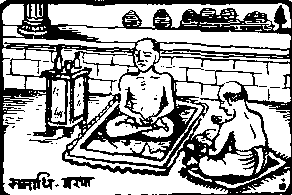Six shields

Chha Dhala
Fourth Dhal

chothi dhal
Characteristics of correct understanding
Difference between correct belief and understanding
Descriptive catagories of correct understanding; Characteristics of "constrained but clear" and "unclear" correct understanding
Characteristics of unconstrained clear understanding; Benefit of correct understanding
Difference between karma removal between those with and those without correct understanding
Problems in understanding; rarity of human-state and suitable environment
Benefit of correct understanding and its origin (cause)
Benefit of correct understanding; Way of quashing desires
Rejection of elation/despair in the consequences of previous good and bad deeds; The very essence of what needs to be done
Initiation of correct conduct and its types; Characteristics of the minor vows of non-violence and truth
Characteristics of minor vows of non-stealing, celibacy, limiting possessions; vow to define, and stay within, geographical boundaries
Characteristics of enhancement to vow of limiting geographical boundaries by specifiying specific regions within those boundaries
Types and characteristics of unnecessary bad deeds
Meditate; devote special days to knowing yourself; reduce possessiveness by limiting consumption; and eat only after feeding worthy receipients
Results of faultless application of the vows of the religious householder

Characteristics of correct understanding

samaygnaannu luxan ane teno samay

samyakt shradha dhari puni, sevhu samyaggnaani,
sva-par arth bahu dharmjut, jo pragatavan bhan. 1.
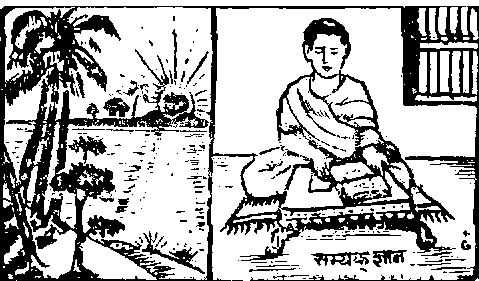
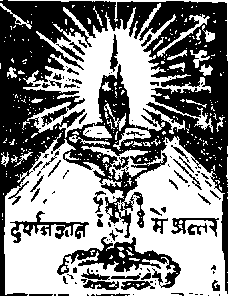

Difference between correct belief and understanding

samyagdarshan ane samyagnaanma tafavat

samyakt sathai gnaan hoy, pai bhin aradho;
luxan shradha jan, duhu may bhed abadho;
samyakt karan jan, gnaan karj hai soie;
yugpadt hotey hu, prakash dipaktey hoi. 2.

Descriptive catagories of correct understanding; Characteristics of "constrained but
clear" and "unclear" correct understanding

samyaggnaanna bhed, parox ane desh-pratyaxna luxam

tas bhed do hai, parox paratchhi tin mahi;
mati-shrut doy parox, ax mantai oopjahi;
avdhignaan manparjay do hai desh-pratccha;
dravya-kshetra pariman liyey janai jiy svachha. 3.
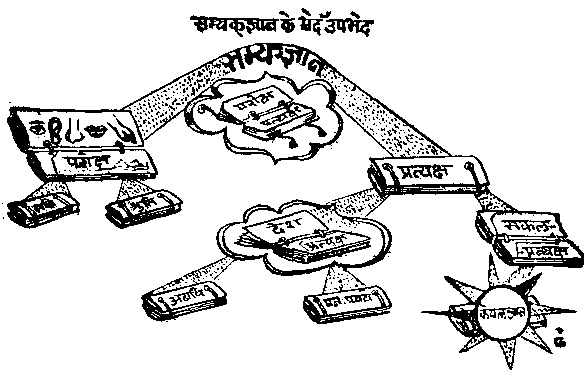

Characteristics of unconstrained clear understanding; Benefit of correct understanding

sakalpratyax gnaannu luxan ane gnaanno mahima

sakal dravyake gun anant, parjay ananta;
janai aekai kal, pragat kevali bhagvanta.
gnaan saman n aan jagatmey sukhko karan;
ihi parmamrut janmjaramruti-rog-nivaran. 4.
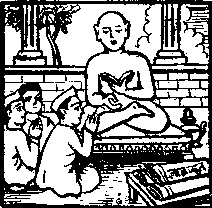

Difference in karma removal between those with and those without correct understanding

gnaani ane agnaanina karmnashna vishayma tafavat

koti janm tap tapai , gnaan vin karm zarai je;
gnaani ke chhin mey, trigupti tay sahaj tarey te.
munivrat dhar anantvar graviak oopjayo;
pai nij atam gnaan vina, sukh lesh n paayo. 5.


Problems in understanding; Rarity of human-state and suitable environment

gnaanna dosh ane manushyaparyay vageyreyni durlabta

tatai jinvar-kathith tattva abhyas karijey.
sanshay vibram moh tyag, aapo lukh lijey ;
yha manushyaparyay, sukul, sunivo jinvani;
ihividh gayey n milai, sumani jyo oodhadhi samani. 6.
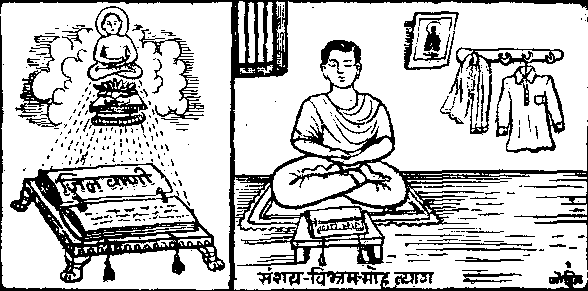
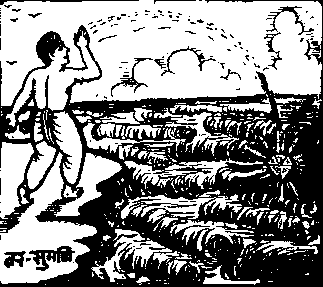

Benefit of correct understanding and its origin (cause)

samyaggnaanno mahima ane karan

dhun samaj gaj baj, raj to kaj n aavai;
gnaan aapko roop bhaye, fir achal rahavai.
tas gnaanko karan, sva-par vivek bakhano;
koti uppay banay bhavya, tako ur aano. 7.
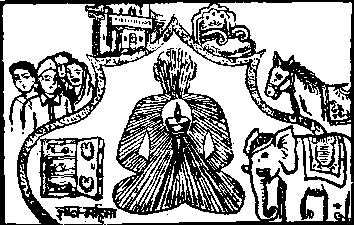

Benefit of correct understanding; Way of quashing desires

samyagnaanno mahima ane vishayoni ichha rokvano oopai

dje purva shiv gayey, jahi aru aagey jehai,
so sab mahima gnaantani, muninath kahai hai.
vishay-chah dav-dah, jagat-jun arni dazavai,
tas oopay n aan, gnaangungan boozavai. 8.
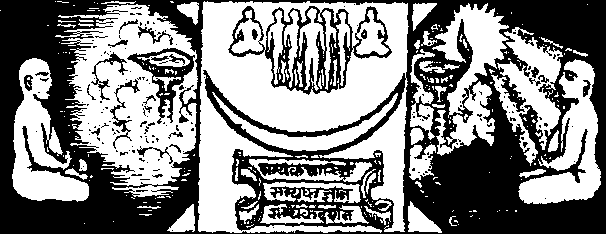
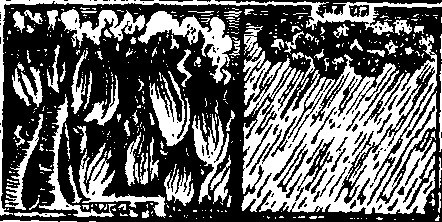

Rejection of elation/despair in the consequences of previous good and bad deeds; The very essence of what needs to be done

punya-paapma harsh-vishadno nished ane saar saar vato

punya-paap-falmahi, harsh vilkho mat bhaie;
yaha pudugal parjay, upji vinsai fir thai.
lakh baatki baat yhai, nischay ur laao;
tori sakal jag-dandfand, nit atam dhyaao. 9.
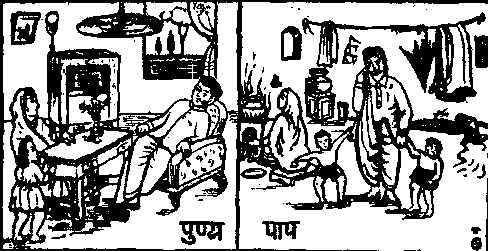
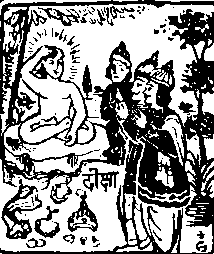

Initiation of correct conduct and its types; Characteristics of the minor vows of non-violence
and truth

samyaktcharitrano samay ane bhed tatha ahinsa-anuvrat ane satya-anuvtrtnu luxan

samyaggnaani hoy, bahuri did charit lijiai ;
aekdesh aru sakaldesh, tasu bhed khijiai.
trashinsa ko tyag, vrutha thaver n sanharay;
par-vadhkar kadthor nind, nahi vayan uchary. 10.
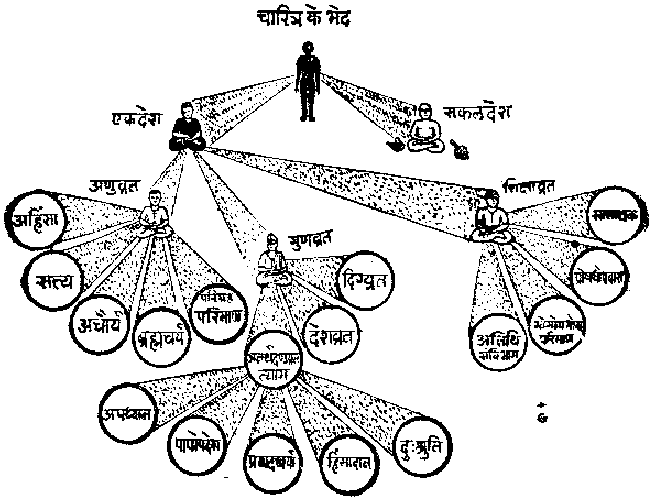

Characteristics of minor vows of non-stealing, celibacy, limiting possessions; vow to define, and stay within, geographical boundaries

achoryanuvrat brahmcharyanuvrat, parigrahparimananuvrat tatha didvratnu luxan

jal mrutika vin aor nahi & kachhu gahai Adtaa;
nij vanita vin sakal nariso rahai virtaa.
apni shakti vichar, parigrah thoro rakhai;
dussh dissh gaman praman ddan, tasu sim n nakhai. 11.
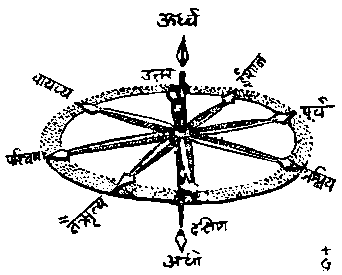

Characteristics of enhancement to vow of limiting geographical boundaries by specifiying specific regions within those boundaries

deshvrat (deshavgashik) namna gurnvratnu luxan

Taahumey fir gram, gali gruh bag bajara;
gamanagamanpraman ddan, aan sakal nivara. 12(purvardh)

Types and characteristics of unnecessary bad deeds

anarthdandvratna bhed ane tenu luxan
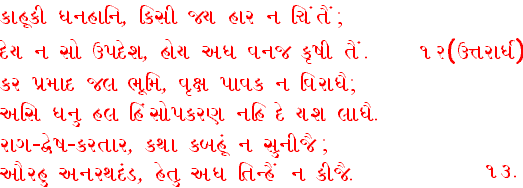
kahuki dhunhani, kisi jayi har n chintai;
dey n so oopdesh, hoy adh vanaj krushi tai. 12(uttarardh)
kar pramad jal bhumi, vrux pavak n viradhe;
asi dhanu hal hinsopkaran nahi dey yash ladhai.
raag-dvesh-kartar, katha kabhu n sunijey;
aorhu anrathdaand, hetu adh tinhey n kijey. 13


Meditate; devote special days to knowing yourself; reduce possessiveness by limiting consumption; and eat only after feeding worthy receipients

samayik, poushad, bhogopbhogpariman ane atithisanvibhagvrat

dhar ur samtabhav sadaa samaiyk kariye,
parav chatustaymahi, paap taj proshad dhariye;
bhog aor upbhog, niyamkari mamat nivaray,
muniko bhojan dey fair, nij karhi aharey. 14
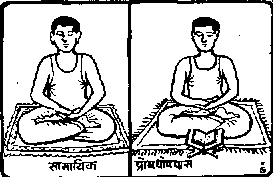
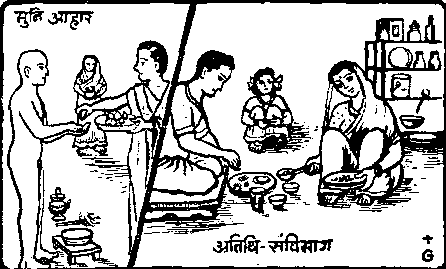

Results of faultless application of the vows of the religious householder

niritichar shravakvrat padvanu fal

barh vrat ke atichar, pan pan n lagavey,
maran samay sanyas dhari, tasu dosh nashavey;
yo shravakvrat pal, svarg solam upjavey;
tahtai chaya narjanm paay, muni havey shiv javey. 15
